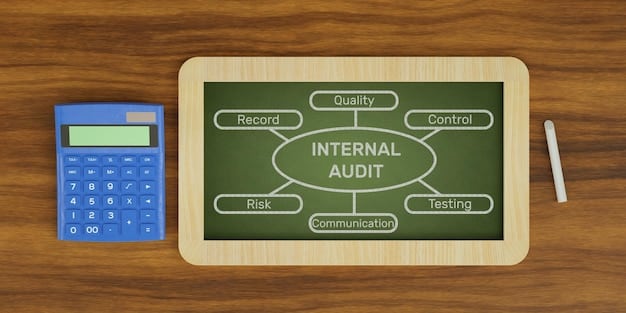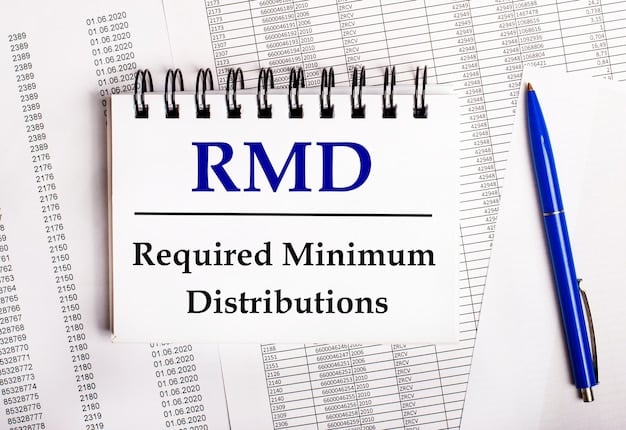Maximize R&D Tax Credits for Small Businesses in 2025

Navigating the Research and Development (R&D) tax credit in 2025 can provide significant financial benefits for small businesses; this guide explores eligibility criteria, qualified expenses, and strategies to maximize these valuable tax credits.
Small businesses are always looking for ways to reduce costs and increase profitability. One often overlooked opportunity is the Research and Development (R&D) tax credit in 2025, which can provide significant financial advantages for companies engaging in qualifying research activities.
Understanding the R&D Tax Credit
The R&D tax credit is a federal incentive designed to encourage innovation and technological advancement within the United States. It allows companies to claim a credit for qualified research expenses (QREs), effectively reducing their tax liability and freeing up capital for further investment in research and development.
Who is Eligible for the R&D Tax Credit?
Many small businesses mistakenly believe that the R&D tax credit is only for large corporations or high-tech companies. However, businesses of all sizes and across various industries can qualify, provided they meet certain criteria. The key requirement is that the company must be engaged in activities that are technological in nature and intended to discover new information or improve existing products, processes, or software.
What Activities Qualify for the R&D Tax Credit?
Qualifying activities aren’t limited to laboratory experiments. They can include a wide range of endeavors, such as developing new products, improving existing ones, creating new software, or enhancing manufacturing processes. The activity must involve a degree of technical risk and uncertainty, and it should aim to overcome a technological challenge.

- Developing new products or processes.
- Improving existing products or processes.
- Creating or improving software.
- Experimenting with new materials or techniques.
Understanding the R&D tax credit is the first step to claiming it. Many businesses often miss out on these credits due to the misconception of its requirements, which is actually quite broader than they think. This leads to many businesses missing a potential opportunity to maximize their funding and investment.
Identifying Qualified Research Expenses (QREs)
Qualified Research Expenses (QREs) are the costs directly related to the qualifying research activities. Identifying these expenses accurately is crucial for maximizing the R&D tax credit. QREs generally fall into three main categories: wages, supplies, and contract research expenses.
Wages
Wages paid to employees who are directly involved in the qualifying research activities are considered QREs. This includes salaries, bonuses, and other forms of compensation. Specifically, it refers to compensation of people involved in hands-on research, direct supervision, or direct support of research activities. Those who are in administrative or other non-qualifying roles cannot be included.
Supplies
The costs of supplies used in the qualifying research activities are also considered QREs. Supplies encompass a wide range of items, such as raw materials, prototypes, and testing materials. While general and administrative supplies like office supplies will not qualify, items that are used up or consumed in activities that meet the requirements may qualify.
Contract Research Expenses
If a company hires a third party to conduct research on its behalf, the expenses paid to the contractor may also qualify as QREs. However, only a certain percentage of the contract research expenses can be claimed, typically 65%.
- Track employee time spent on qualifying research activities.
- Keep detailed records of supply purchases used for research.
- Maintain contracts and invoices for contract research expenses.
Accurately identifying and documenting your QREs is essential for maximizing your R&D tax credit claim. Be as accurate as possible in categorizing your expenses and consult with a tax advisor regarding what counts as a QRE.
Navigating the R&D Tax Credit Calculation
Calculating the R&D tax credit can be complex, as it involves several factors, including the company’s gross receipts and base amount. However, understanding the basic steps involved can help small businesses estimate their potential credit and ensure accurate reporting. There are two main methods for calculating the tax credit: the regular credit and the alternative simplified credit (ASC).
Regular Credit
The regular credit involves comparing the company’s current-year QREs to its base amount. The base amount is calculated based on the company’s average gross receipts from the previous four years. The credit is then calculated as 20% of the amount by which the current-year QREs exceed the base amount.
Alternative Simplified Credit (ASC)
The ASC is a simplified method that is often more beneficial for small businesses. It involves calculating the credit as 14% of the current-year QREs that exceed 50% of the average QREs from the previous three years. If a company has no QREs in any of the three previous years, the ASC is calculated as 6% of the current-year QREs.

- Determine your eligibility for the regular credit or the ASC.
- Calculate your base amount or average QREs from the previous years.
- Apply the appropriate credit rate to the excess amount.
The calculation method can vary based on the gross receipts or expense of the company. It is best to consult with a tax advisor to determine which method you will be using and what expenses are eligible when computing for the tax credit.
Documenting and Substantiating R&D Activities
Proper documentation and substantiation are critical when claiming the R&D tax credit. The IRS requires businesses to maintain detailed records of their qualifying research activities and expenses to support their claim. Failure to do so can result in the disallowance of the credit. Businesses should keep track of every meeting, trial, experiment as well as the people involved and their salaries.
What Documentation is Required?
The required documentation includes records of employee time spent on qualifying research activities, invoices and contracts for supplies and contract research expenses, and technical documentation describing the nature of the research activities. This documentation should be organized and readily accessible in case of an IRS audit.
How to Maintain Accurate Records
To ensure accurate record-keeping, businesses should implement a system for tracking their research activities and expenses. This may involve using time-tracking software to monitor employee hours, maintaining a detailed expense log, and creating a central repository for all research-related documents. Every expense should be properly documented for the purposes of getting the R&D tax credit.
Maintaining proper documentation is extremely important when filing for an R&D tax credit to present your qualified expenses. Be as accurate as possible when dealing with documents and reports pertaining to research information and data.
The R&D Tax Credit and Startups
The R&D tax credit can be particularly beneficial for startups, as it can provide valuable cash flow to support their growth and innovation. In some cases, startups may even be able to monetize the credit by carrying it back to previous tax years or forward to future tax years. The R&D tax credit can be claimed even by startups that are starting out and haven’t incurred enough tax for the government to give the full credit.
The Payroll Tax Credit for Qualified Small Businesses
A qualified small business (QSB) that is a startup can elect to use the R&D tax credit against its payroll tax liability, rather than its income tax liability. To be a QSB, the taxpayer must have gross receipts of less than $5 million for the tax year and must not have had gross receipts for any tax year preceding the five-year period ending with the tax year.
How Startups Can Maximize the R&D Tax Credit
To maximize the R&D tax credit, startups should carefully track their qualifying research activities and expenses, maintain accurate records, and consult with a tax professional to ensure compliance with the IRS regulations. Startups should also explore opportunities to carry back or carry forward the credit to maximize its value.
- Understand the eligibility requirements for the payroll tax credit.
- Track QREs and maintain accurate records.
- Consult with a tax advisor to ensure compliance.
For a startup, the R&D tax credit provides financial assistance that allows a startup to sustain their operations. This tax credit directly funds innovation and growth needed to help the business navigate its early stages. It also validates the commitment to innovation by the startup since they are actively looking for ways to improve their research.
Common Mistakes to Avoid
Many businesses make common mistakes when claiming the R&D tax credit, which can result in the disallowance of the credit or even penalties from the IRS. Avoiding these mistakes is crucial for maximizing the benefits of the credit and ensuring compliance with the tax laws.
Misclassifying Expenses
One common mistake is misclassifying expenses as QREs when they do not meet the eligibility requirements. For example, expenses related to administrative activities or routine product testing may not qualify for the credit.
Failing to Maintain Adequate Documentation
Another common mistake is failing to maintain adequate documentation to support the R&D tax credit claim. Without proper documentation, the IRS may disallow the credit during an audit.
Overlooking Qualifying Activities
A lot of businesses overlook a lot of their activities that are actually deemed eligible for the R&D tax credit. They may mistake the requirements of the credit or are simply too short-sighted to think that the activities they are doing would qualify as QREs.
| Key Point | Brief Description |
|---|---|
| 💡 Eligibility | Companies engaging in technological activities qualify. |
| 💰 QREs | Include wages, supplies, and contract research expenses. |
| 📝 Documentation | Maintain detailed records of activities and expenses. |
| 🚀 Startups | Can utilize credits against payroll tax or carry them forward. |
Frequently Asked Questions (FAQ)
Businesses of all sizes across various industries can qualify if they engage in activities that are technological in nature, aiming to discover new information or improve existing products or processes.
QREs include wages, supplies, and contract research expenses directly related to qualifying research activities. This covers costs tied to developing or improving products, processes, or software.
The credit can be calculated using the regular credit method or the alternative simplified credit (ASC). The ASC is often more beneficial for small businesses, offering a simpler computation.
Businesses must maintain detailed records of employee time spent on research, invoices for supplies, contracts for research expenses, and technical documentation describing the research activities performed.
Yes, startups can benefit significantly. They may use the credit against payroll tax liabilities or carry it back/forward. They can also utilize the payroll tax credit for qualified small businesses.
Conclusion
Navigating the Research and Development (R&D) tax credit in 2025 can be a transformative step for small businesses aiming to boost innovation and financial health. By understanding eligibility, tracking expenses, and avoiding common pitfalls, companies can unlock significant tax savings and fuel future growth.





